Oil Flasks |
 |
 |
 |
 |
Lekythos |
Tall body, a offset neck with a heavy mouth, a vertical
handle on back and a heavy stand. It was used to store
the perfume oil and the word "Lekythos"
was used not only for the shape, but also for the
aryballos or alabastron.
Lekythos was produced from the beginning of the black-figure,
though there are some shapes, such as a one with round
body, or vase called "Deianira Lekythos", which has a long oval body.
In the late sixth century, lekythos with offset shoulder
was introduced, in which there are two varieties "standard"
and "secondary".
In the first half of the fifth, "Squat
lekythos" with heavy body and "acorn
lekythos" with a relief ornament like a upper
part of a acorn.
|
 |
Deianira Lekythos |

Tall oval body with a cup-shaped thick mouth, a heavy
stand and a vertical handle. This shape was produced
from the beginning of the black-figure to the middle
of the sixth century. Cf. Tampa 86.15 (Perseus
Project).
The figured scene is arranged on the body and sometimes
on the shoulder too.
Dimensions: height about 20cm
|
 |
Standard Lekythos |
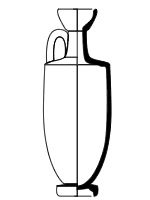
Tall cylindrical body with a offset shoulder, a tall
neck with heavy mouth, a vertical handle and heavy
stand and the diameter is largest on the body. Cf.
Rhode 22.216 (Perseus
Project).
This shape was introduced about the late sixth century
and white ground lekythos used as a offering was produced
since the second quarter of the fifth century, though
disappeared in the early fourth.
Figured scene is arranged on the body and rarely on
the shoulder, where usually a five-palmette pattern
is preferred.
Most of the white ground lekythoi have a scene connected
with a funeral. The form became slender in later period
with a tall neck and some examples have a second vase
inside the body to save oil.
Dimensions: height about 30cm, though in the age of
the red-figure many lekythoi under 20cm high were
also produced. In the end of the fifth century, white
ground lekythoi over 1m high were made.
|
 |
Secondary Lekythos |
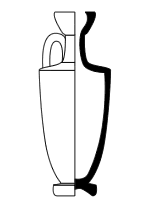
The form is similar to the standard shape, though
this is usually small and the largest diameter is
on the shoulder.
This shape was introduced about the second quarter
of the fifth century and favoured in the middle of
the century, though disappeared soon. Most of these
have white ground.
The subject is same as the standard shape, although
the picture is worse than that. Cf. Rhode 06.050 (Perseus
Project).
Dimensions: height about 20cm
|
 |
Squat Lekythos |
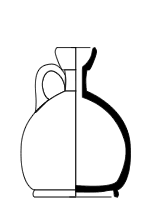
Round squat body and offset neck with a heavy mouth
and a handle. This shape was introduced in the first
half of the fifth century and favoured later.
Figured scene is arranged on the body and some later
example have a flourished ornament on back. The form
became slender in later phase. Cf. Erlangen
(Antikensammlung
Erlangen Internet Archive).
Dimensions: height about 20cm, though there are many
examples under 10cm.
|
 |
Acorn Lekythos |
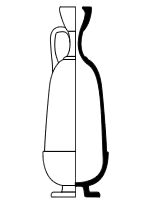
Tall slightly squat body with a relief dot ornament
on the lower part, which remind us a acorn, tall neck
with heavy mouth, a vertical handle and a heavy stand.
This shape is rare and produced only in the late fifth
century. Cf. Boston
95.1402 (Perseus
Project).
The way of decoration is similar to the other lekythos,
though the relief part is reserved the clay-surface.
Dimensions: height about 20cm
|
 |
Aryballos |
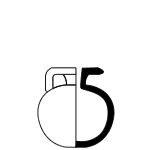
Round body with a disk-shaped mouth and one or two
handle, former has its origin in Corinthian shape
and older than latter. The name "Aryballos"
was probably used for the shape. This vase seems to
be used by men, while "Alabastron"
by women. In the vase-painting, it is depicted in
palaestra scene sometimes with a figure scratching
off his sweat with oil by Strigil. Cf. Paris, Louvre CA2183 (Perseus
Project).
There are some examples in the shape of human head.
The figured scene is simple and applied on the body.
Dimensions: height about 5-10cm
|
 |
Alabastron |
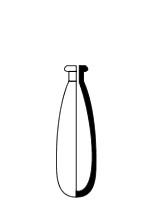
Tall body with a round bottom and a small mouth.
There is no handle, though sometimes it has string
holes or ears. The name "Alabastron" is
probably from the Egyptian word "A la baste"
means "vase of Ebaste (goddess)".
Alabastron was used by women and often depicted on
the vase-painting. It was introduced in late sixth
century and favoured in the end, though disappeared
in late fifth century.
Figued scene is arranged around the body, where sometimes
have only a palmette pattern. Cf. Tampa 86.84 (Perseus
Project).
Dimensions: height about 15-20cm
|
 |
Askos |
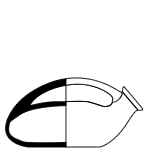
Circular body, convex top, and arched handle meeting
the spout. The name "Askos" means wineskin
and applied to the shape because of the resemblance
of the form, though there is no evidence to prove
Greeks had used the name for it.
This shape was appeared in the early fifth century
and all of them are painted by red-figure. There is
another shape in the form of the lobster craw.
Figured scene is arranged on either side of the body.
Cf. Rhode 25.074 (Perseus
Project).
Dimensions: diam. about 10cm and the diam. of the
Lobster class is about 15cm.
|
 |
Kothon |
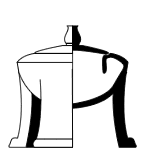
Shallow bowl with turned in rim, three broad feet
and a lid with a knob. The name "Kothon"
was used not for the shape but for the cup. Cf. Paris, Louvre CA616 (Perseus
Project).
This shape was probably succeeded by "Plemochoe"
and used as a oil jug. It was produced in the early
age of the black-figure.
Figured scene is arranged on the feet and the lid,
and sometimes on the lip.
Dimensions: height about 10cm
|
 |
Plemochoe |
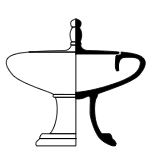
Shallow broad bowl with turned in rim, tall stand
and a lid with a knob. It was used as a oil container.
The name "Plemochoe" is from the word "preme"
means to overflow and "cheo" means pouring,
and some literary evidences probably prove that Greeks
had used this name for the shape. In the vase-painting,
this shape is sometimes depicted in the wedding scene,
probably used in a ritual. Cf. RISD 16.040 (Perseus
Project).
There is no example with figure decoration, except
for a Boeotian example, and some simple ornament are
arranged.
Dimensions: height about 15cm
|
 |
Amphoriskos |
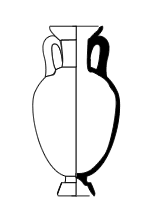
Miniature vase of Amphora, especially of panathenaic
shape. Cf. Berlin inv.30036 (Perseus
Project).
Black-figure painters liked to paint the same subject
as panathenaic amphoras, though later painter preferred
to depict their own subject.
Dimensions: height about 10-20cm
|
 |
Lydion |
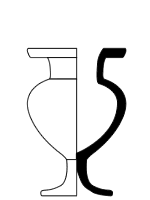
Round body with a disk-shaped mouth and a tall stand.
This shape has a origin in the vase made in Lydia,
though is very rare in the Attic workshops and painted
by the black-figure only.
Figured scene is applied on the body, although the
figures are generally rough. Cf. Harvard 1960.307 (Perseus
Project).
Dimensions: height about 10cm
|
|
 |
|
|
|